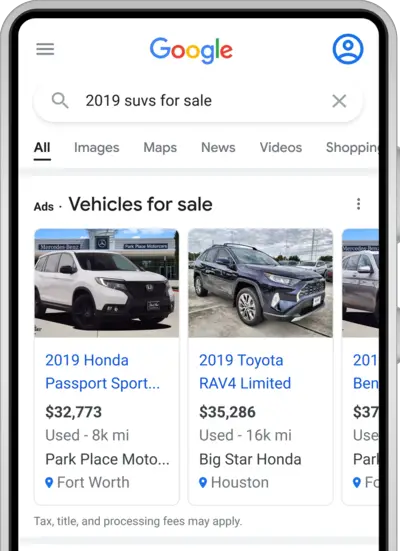Vehicle ads are a performance-focused, lower funnel ad format which allows auto advertisers to promote their entire inventory of vehicles to interested customers shopping for vehicles on Google. This format shows customers an image of the vehicle with important information such as make, model, price, mileage, and advertiser name. Showing inventory of available vehicles both enriches the customer's purchase experience and provides more qualified leads for auto advertisers.
Vehicle ads help advertisers drive sales by optimizing for both online conversions (leads) and offline conversions (store visits).
Clicking on a vehicle ad will take the customer to the vehicle description page (VDP) on your website. From there, they can perform additional actions such as contacting the dealer, filling out a lead form, etc. before visiting the dealership. If you’re a US auto advertiser and interested in participating, contact us here.
Benefits
Vehicle ads help you get in front of auto shoppers online at the right moment, with the right listings and information to move them closer to a purchase. Key benefits include:
- More qualified leads: Showing customers key information and visuals about the car before they click, helps provide more qualified leads
- Omnichannel goals: Optimize for both online conversions (leads) and offline conversions (store visits)
- Automated targeting: Vehicle ads automatically show your most relevant listings for a related user query
- Increased exposure: Serve alongside your text ads on Google
Availability
Vehicle ads support both new and used vehicle inventory from dealer or retailer stock. Vehicle ads from private sellers, individuals, or auto brokers are not permitted.
Vehicle ads may be used to promote only non-commercial passenger vehicles, such as cars or pickup trucks (utes in AU).
Examples of not-allowed vehicle types are recreational vehicles, commercial vehicles, farm vehicles, buses, 2-wheelers, trains, boats, airplanes, or outdoor utility vehicles.
Vehicle ads are currently available in the US and in a limited beta in select countries. If you’re a US auto advertiser and interested in participating, contact us here. For auto advertisers in Canada and Australia, contact your Google representative if you're interested in participating.
How vehicle ads work
Advertisers are required to upload their vehicle data feed to Merchant Center. The advertiser’s feed must contain pertinent details about their vehicles, including make, model, price, mileage, color, and more. Google uses these details to match a customer's search to the most relevant cars.
To use vehicle ads, you must create Smart Shopping campaigns on Google Ads. You must also link your Google Ads account to a Merchant Center account and a Google Business Profile. A store feed alternative to Business Profile linking is available if you don’t own or manage the profiles for your dealer locations.
Vehicle ads target customers at the bottom of the funnel, closer to selecting a specific vehicle, configuration, and/or dealer. The format appears on queries with a high car shopping intent.
Related links
- Vehicle ads overview
- Implementation guide
- Vehicle ads policies and guidelines
- Vehicle ads Content API guidelines
In terms of effectiveness, Google says “advertisers who complemented their existing Search campaigns with vehicle ads saw a +25% average increase in conversions during beta testing.” Specifics include:
- Used car inventory: “Asbury drove a 35% increase in conversions and a 12% increase in conversion value.”
- “Ken Garff drove 55% more conversions at nine dealerships in the first half of 2021.”
- “Powered by machine learning and automation, vehicle ads have driven incremental visits to CarMax’s website and have helped CarMax connect more shoppers with their next car.”



